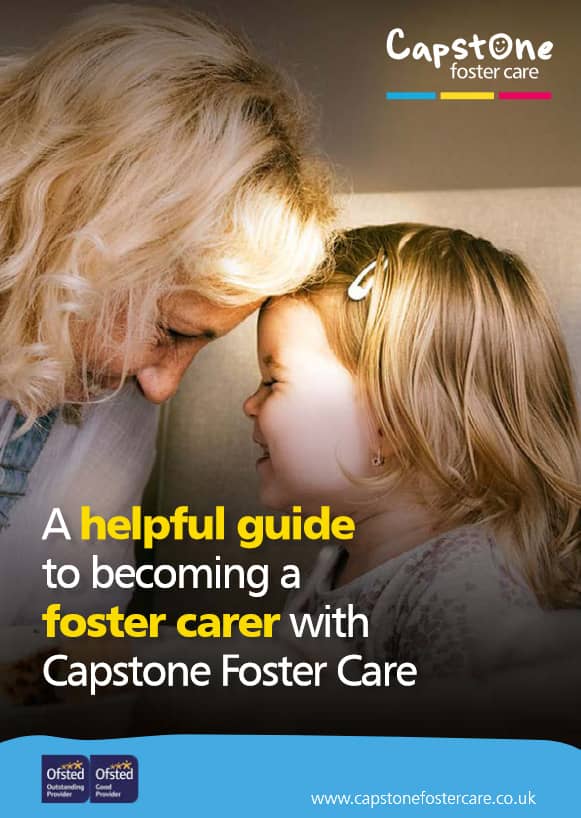


Fostering a disabled child
The role of an independent fostering agency
How to choose a foster care agency
Can I choose who I foster?
What are the benefits of fostering with an independent fostering agency?
What happens when a child is taken into care?
Fostering process: what happens on an initial home visit?
Fostering with local authority vs independent agency
A complete guide to becoming a foster carer
How Are Children in Foster Care Matched with Carers?
Foster Care Budgeting Tips
Becoming A Foster Carer
What is a Care Leaver?
What is a Foster Carer?
Fostering Regulations
How long does it take to become a Foster Carer?
What are the Foster Care requirements?
Changing IFA - Transferring to Capstone
8 reasons why a child may be taken into care
Fostering as a Career
Can you foster if you smoke or vape?
A guide to fostering assessments
LGBTQ+ Fostering
Equality, Inclusion & Anti-discriminatory Practice in Foster Care
What can disqualify you from foster care?
Can you foster if you’re on benefits?
Top transferable job skills to become a foster carer
Fostering as a same sex couple
Fostering while renting
Can you foster if you have mental health issues?
Is there an age limit for fostering in the UK?
Do foster carers get a pension?
How to foster a child: A step by step guide
How do DBS Checks Work?
Can I foster if...?
Mythbusting the top 10 Foster Care Myths
Can I foster if I am disabled?
LGBT Fostering Mythbusting
Can I foster if I have pets?
Can I Foster A Child?
Can I Foster and Work?
Can you Foster with a Criminal Record
Can Single People Foster?
LGBT Family and Foster Care
Fostering across Cultures
Muslim Fostering
Christian Foster Care
Sikh Fostering
Empty Nest Syndrome and Foster Care
Can I Foster?
What is the difference between residential care and foster care?
Fostering Babies and Young Children
What is Kinship Care?
Fostering Babies - Myths
Focusing on Parent & Child Fostering
Fostering Siblings
Fostering Teenagers
Fostering Teenagers - Breaking down the Myths
Fostering Unaccompanied and Asylum Seeking Children
Mother and Baby Foster Placements
Private Fostering
How does therapeutic fostering work?
Young Children Fostering Placements
Difference between short and long-term fostering
Types of self-harm
A Guide to the Foster Care Handbook
Reunification and Birth Parents: A Guide for Foster Carers
What is an EHC Plan? A Guide for Foster Carers
How to prepare a child for becoming a care leaver
Children who foster: impact of fostering on birth children
Fostering LGBTQ+ Youth
How to prepare your home for a foster child
How to help a lonely child: A Guide for Foster Carers
What are the National Minimum Standards for Fostering Services?
10 tips for foster children's education
How to prepare your foster child for secondary school
Tips for coping when foster placements end
Tips for foster parents during Coronavirus
What happens if foster parents get divorced?
5 ways to manage Mother's Day with foster children
Tips for managing foster children's bedtime routines
How to handle foster child bullying
Fostering allowances and the gender pay gap
What discounts can foster carers get?
How to adopt from Foster Care
5 ways to manage Father's Day for children in foster care
8 most common fostering challenges
FosterTalk Membership with Capstone Foster Care
Supporting foster children's contact with birth families
A guide to independent fostering
Keeping Children Safe Online: A Guide For Foster Carers
Movies About Foster Care
Play-based learning strategies for foster carers
A Guide to the Staying Put Program
How to deal with empty nest syndrome
How to recognise signs of depression in foster children
Can you take a foster child on holiday?
Tips and advice on fostering with a disability
10 tips on connecting with your Foster Child
Fostering vs Adoption - What's the difference?
How Fostering can change a future
How to adopt from Foster Care
How to encourage children to read in Foster Care
How to prepare a Foster Child's bedroom
Reading and Storytelling with Babies and Young Children
Supporting Children's Learning
The 20 most recommended books Foster Carers and young people should read
Things you can do when your children leave home
The impact of early childhood traumas on adolescence and adulthood
Anxious Disorders in Foster Children
What is sexual abuse and sexual violence
Foster Child behaviour management strategies
Foster Parent Advice: What to expect in your first year of fostering
Capstone's twelve tips at Christmas
10 celebrities who grew up in Foster Care
Could Millenials be the solution to the Foster Care crisis?
Do you work in Emergency Services?
Form F Assessor and Assessment Training
Foster Care Fortnight
Improving Children's Welfare - Celebrating Universal Children's Day
New Year - New Career - Become a Foster Carer
Young People Charities
As a prospective foster parent or adoptive parent, it’s important to understand the differences between fostering and adoption to make an informed decision. Both fostering and adopting a child offer a chance to help vulnerable children and young people. It’s important to note that at Capstone we specialise in fostering, and do not offer Adoption or Foster-to-Adopt services. When choosing whether to foster or adopt, there are significant differences to consider.
In our helpful guide we’ll explain the difference between fostering vs adopting a child including;
So, should you choose to foster or adopt? Let’s look at the differences between becoming a foster parent and an adoptive parent.
The main difference between fostering and adoption is that while fostering can be long-term, it can also be temporary or short-term. Whilst adoption is usually permanent.
The other main difference between adoption and fostering is that although you are in the role of a parent as a foster carer, the local authority and the child’s original parents or guardians retain responsibility for the child too. In contrast, when you adopt a child, you assume full legal parental responsibility, and the child or young person becomes a legal member of your family permanently.
If you’re interested in adopting or fostering, it’s important to understand what is required for each option.
The main requirements to become a foster parent include meeting the key criteria:
We often get the question “Can I foster if…?” and our helpful guide covers most of these queries. However, if you have any other questions our helpful team will be happy to advise.
If you meet the initial key criteria you’ll be assessed for your suitability to become a foster carer, which will include the Form F Assessment and home visit.
When applying to become an adoptive parent there is also key criteria that needs to be met.
Also, the child’s birth parents must both agree to consent to the adoption, unless:
To apply to adopt, you must go through a two-stage adoption process. The goal of the two-part process is to help would-be adopters get ready to apply to adopt in six months’ time. The first part involves learning about what adoption entails as well as giving the adoption agency time to check each applicant’s references - this takes about two months.
The second part takes about four months and is an extension of the assessment process, during which the potential adopters are prepared for the application process.
One difference between fostering and adoption is that of demand. There are approximately 75,000 children and young people in foster care in the UK. Of these, 6,800 need a foster home, and this number is rising every year. On the other hand, there are slightly fewer children who need adoption every year, around 6,000 with 2,950 children adopted in 2022.
When you are approved as a foster carer, your first placement is likely to take place quite quickly. This is because there are many foster children who need a home as soon as possible.
In contrast, adopters may not find a suitable match as quickly. If a match in your geographical area is not found within a three-month period, your information goes to the National Adoption Register. The National Adoption Register matches children waiting to be adopted with approved adopters.
When you bring your foster child home, you’ll be working together as a team with your social worker and support network here at Capstone to meet the key fostering outcomes outlined in the “Every Child Matters” initiative. These include:
To help you in your fostering career, we also provide a wealth of training and support in both a personal and professional capacity, in order to support you and your foster child. Including our own bespoke training and support for therapeutic fostering placements.
In adoption, you are transferred full legal parental rights - there will be initial contact with a support network from your local authority’s post-adoption team. You will also be entitled to adoption leave, which is similar to maternity leave, allowing time off work to care for the child.
The cost differences between fostering a child and adopting a child can vary widely. The main difference is with adoption. Typically, you pay to adopt a child. However, this price depends on several factors including adoption agency fees. With fostering, because it’s a career, you are paid for the skills needed to take care of a child - this will vary in cost whether you are fostering with an independent agency or local authority, the age of the child and type of fostering.
Adoptive parents may be eligible for an adoption allowance, which is a means-tested payment to help with the costs of raising an adopted child.
Adopting a child can be an expensive process. The application process to adopt with the Independent Adoption Panel has a price tag of between £4,000 and £9,000. In addition, you need to pay the Department of Education £885 to process your application and provide your Certificate of Eligibility. If your income exceeds £45,000, this fee goes up to £1,775. The average total cost of adopting a child in the UK ranges between £10,000 to £15,000. This includes costs such as agency fees, legal fees, and the cost of background checks and home studies.
It’s important to remember that the decision whether to foster or adopt a child should not be based on cost alone. The main priority should be to provide a safe and loving home.
Some adoptive parents will be eligible for the Adoption Support Fund, which is a government funded scheme that provides financial support for therapeutic services for children who have been adopted.
The fostering allowance is a payment received by foster carers to cover the cost of caring for a child. In an independent fostering agency - or a trust like Capstone – foster carers will also be paid for their time and skills in looking after a child. The amount paid will depend on a number of factors, including:
The minimum fostering allowance is between £137 and £240 a week through a local authority. Through Capstone, standard payments start at £400 a week. For more information on how much foster parents get paid, read our full guide.
The goal of fostering is not usually adoption, although it does sometimes happen. Typically, foster children do not become available for adoption. If you do foster a child who becomes adoptable, there are a couple of factors to consider.
First of all, being approved as a foster carer is not the same as being approved as an adoptive parent, so you will have to go through the approval process to adopt. You’ll also need to consider how your relationship with the original family may affect the adoption process.
An option for some foster parents who wish to adopt is “Fostering for Adoption” where children in care are being assessed with a view to adoption as an outcome. Potential adopters may foster the child while the decision is being made as this protects the child from being moved repeatedly.
This happens when the local authority or fostering agency reviews approved adopters and accepts them as temporary foster carers for the child. This is known as dual approval. The dual approval family are treated as foster carers, which means that the local authority and birth family have parental responsibility. The foster carers are paid a fostering allowance. However, adoption is not guaranteed, and there is the risk of the final decision being that the child will not be adopted.
Concurrent planning is similar to fostering for adoption in that the potential adopter fosters until the decision is made about the child’s future. Concurrent planning refers to babies and toddlers under the age of two, and the same approach as with fostering for adoption holds true.
The concurrent carer is a foster carer while the decision is being made, and as such, must work with the birth parents during the assessment. If the court decides that adoption is the best solution, the child stays with the concurrent carer, who is then able to adopt the child.
Whether to foster vs adopt is a difficult decision. Choosing between fostering and adoption ultimately depends on your individual circumstances and goals. Both options give children and young people the opportunity to benefit from stability and support in a loving home. Both fostering and adoption have their own unique challenges and benefits, so you should carefully consider your own situation before making a decision.
If you still need help deciding or want to know more information about the difference between fostering and adoption, get in touch with a member of our helpful team here at Capstone Foster Care.
If you’ve got any questions or would like to find out more about fostering with Capstone, fill out the form below.
An experienced fostering advisor from your local area will then be in touch.

Start the conversation today. Our team of friendly advisors are on hand to answer any foster care questions you may have. We can offer you honest and practical advice that can help you decide if becoming a foster carer is the right path for you.


